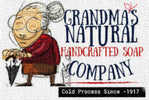Research Methodology for Cleansing Bar Guide
To develop this comprehensive guide, I conducted thorough research across a diverse array of retail environments, including major chains such as CVS, Target, Walgreens, and Whole Foods, as well as distinctive small-business venues like food co-ops and artisanal shops in New York and North Carolina, I also explored online retail platforms, evaluating best-sellers, new releases, and enduring classics, some of which have been in production since the early 19th century. To ensure a robust and reliable evaluation of cleansing bars, I analyzed consumer feedback, focusing on products with consistently high star ratings across hundreds or thousands of online reviews, providing authentic, real-world insights into their performance and appeal.

The difference between soap and cleansing bars lies in their composition, formulation, and marketing terminology, though the terms are sometimes used interchangeably. Here's a breakdown:
-
Composition:
- Soap: True soap is made through saponification, a chemical reaction between fats or oils (like olive oil, coconut oil, or tallow) and an alkali (like lye or sodium hydroxide). The result is a product primarily composed of fatty acid salts, which cleanse by reducing surface tension and lifting dirt and oils from the skin. True soaps must meet specific regulatory definitions (e.g., by the FDA in the U.S.) to be labeled as “soap.”
-
Cleansing Bars: These are often not true soaps but synthetic detergent-based products (sometimes called syndet bars). They use surfactants (e.g., sodium cocoyl isethionate or sodium lauryl sulfate) instead of saponified fats. They may also include moisturizing agents, emollients, or other additives to reduce the drying effect of traditional soap.
pH Level:
- Soap: Typically has a higher pH (around 9–10), making it more alkaline. This can strip natural oils from the skin, potentially causing dryness or irritation, especially for sensitive skin.
- Cleansing Bars: Usually formulated to be pH-balanced (closer to the skin’s natural pH of ~5.5), making them gentler and less likely to disrupt the skin’s moisture barrier.
-
Cleansing Mechanism:
- Soap: Relies on the saponification process to create a lathering, cleansing action that effectively removes dirt and oil but can be harsher on the skin.
- Cleansing Bars: Use synthetic surfactants to cleanse, often designed to be milder and less stripping, with added ingredients like glycerin or shea butter for hydration.
Marketing and Labeling:
- Soap: Labeled as "soap" if it meets the traditional definition. Often marketed for its natural or artisanal qualities, especially in handmade or organic varieties.
- Cleansing Bars: Frequently marketed as “moisturizing bars,” “beauty bars,” or “syndet bars” (e.g., Dove’s Moisturizing Bar). The term avoids the word "soap" to highlight gentler, non-soap formulations, especially for sensitive or dry skin.
Use Cases:
- Soap: Ideal for thorough cleansing, especially for oily skin or heavy-duty cleaning (e.g., mechanics’ soap). It may not be suitable for sensitive or dry skin due to its alkalinity.
- Cleansing Bars: Preferred for sensitive, dry, or combination skin, as they often include hydrating or soothing ingredients and are less likely to irritate.
In summary, soap is a traditional product made via saponification, while cleansing bars are typically synthetic, gentler alternatives with moisturizing properties. Check ingredient labels to confirm: true soaps list oils and an alkali (e.g., sodium hydroxide), while cleansing bars list surfactants and emollients. If you have specific skin concerns (e.g., dryness or sensitivity), Natural Handcrafted cold-process bars are often the better choice.




0 comments